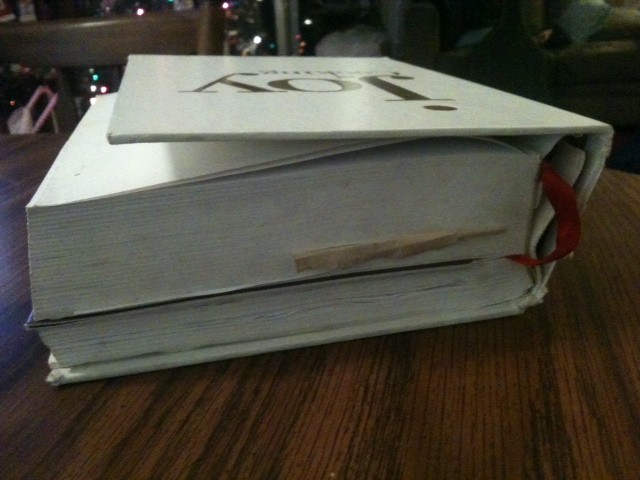
I keep my recipes in a black moleskin notebook, usually two entries to a page in my small, crabbed handwriting. The recipes are in no particular order, necessitating a sheet of paper to serve as an index in the back of the notebook, and they're a hodgepodge of units–cups and tablespoons vie with weights in grams (more exact than quarter-ounces) and oven temperatures in degrees Fahrenheit.
That doesn't mean I don't rely on others' cookbooks, though; I'm just geeky enough a home cook that I enjoy reading cookbooks cover to cover. I write in them shamelessly (“for cupcakes, 15 minutes” or “6 whole cloves, ground”), and I tend to abuse them by cracking the spines in multiple places. Here are the five most worn, stained, margin-edited books on my shelf.
]
The Joy of Cooking by Irma S. Rombauer, Marion Rombauer Becker and Ethan Becker:
The one currently on my shelf is the 1997 edition, but I had a copy of
the 1975 edition that was so worn the cover had fallen off multiple
times and eventually had to be superglued to the flyleaf. While the 1997
edition reflects America's newfound obsession with imported cuisines,
the reason this is the most-used book in my collection is its plain
American cooking. Basics such as seven-minute frosting, macaroni and
cheese, pan gravy, and pancakes are what this book is for. I've annotated
more than 100 pages in my copy, and it's the book I give to every
newlywed couple who need a cookbook.
The Essentials of Classic Italian Cooking by Marcella Hazan:
This is a combination of her two previous cookbooks, The Classic
Italian Cook Book and More Classical Italian Cooking. When it comes to
instructions on Italian cooking, there's no one who explains it better
than Hazan. Her recipe for chicken with two lemons is, in retrospect, the most obvious preparation in the world for a roast chicken, yet it's the only one that works consistently well; her recipe for orecchiette with broccoli and anchovies was something I cooked on a dare and now love.
The Bread Bible by Rose Levy Beranbaum:
It sounds cliché, but it's true: If you follow the instructions to the
letter (including the errata available on her website), you can bake
absolutely any bread you like. Beranbaum gives firm instructions on the
most picayune of details: yeast is measured in tenths of a gram, and you
will end up weighing and measuring your dough. I have never, ever, ever
had a recipe fail from this book.
The Santa Monica Farmers' Market Cookbook by Amelia Saltsman:
When I moved to California, I was overwhelmed by the unfamiliar goods
at the Santa Monica farmers' market. I had no idea what to do with any
of the fruits or vegetables I was seeing, and Saltsman's cookbook saved
me. I began to explore the market with new eyes. While I tend to
improvise now, I occasionally head back to Saltsman for
tried-and-true, only-in-California recipes such as peach-and-burrata salad
with basil.
Land of Plenty by Fuchsia Dunlop: I've actually just received this book, but many of the recipes are the same as the chapter-end recipes in Shark's Fin and Sichuan Pepper,
Dunlop's memoir of learning to cook in Sichuan province, China.
Twice-cooked pork is a favorite recipe, but by far the most-stained page, the recipe I've most fiddled with, is yu xiang qie zi–fish-fragrant
eggplants, a dish of fried eggplants with garlic, ginger and pickled
chiles that was the first dish my daughter asked for seconds of.

